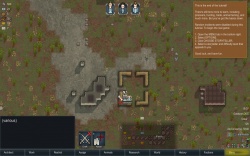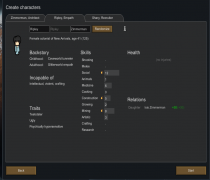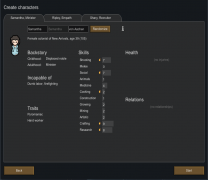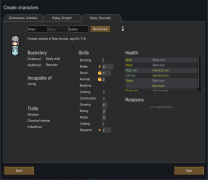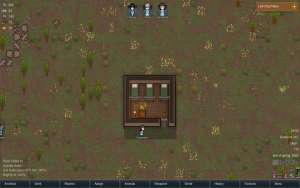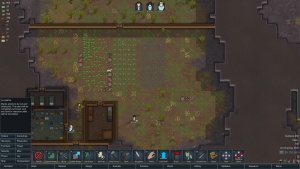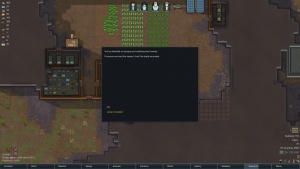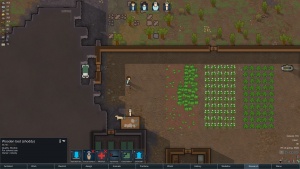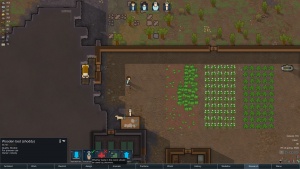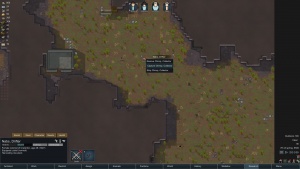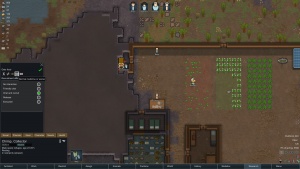Difference between revisions of "Basics"
PigeonGuru (talk | contribs) m |
PigeonGuru (talk | contribs) |
||
| Line 60: | Line 60: | ||
</gallery> | </gallery> | ||
| − | Aim to get all three colonists who combined are incapable of none. Additionally, at least one colonist should be proficient in the following skills (you are aiming for 5+ skills, max is 20): | + | Aim to get all three colonists who combined are incapable of none. Additionally, at least one colonist should be proficient in the following skills (you are aiming for 5+ skills with passion, max is 20): |
* Social - Recruiting new colonists | * Social - Recruiting new colonists | ||
| Line 169: | Line 169: | ||
If you are coming from the Tutorial, you will already have your [[Horseshoes pin|horseshoe pin]], if not, build one and that will clear the notification list on the right. Joy counters stress and as you progress through the rise of your colony continue upgrading their entertainment by adding other items such as [[Chess table|chess table]] (with dinning chairs) and [[Billiards table|billiards table]]. Note that joy is also performed by other actions that do not require you to construct anything, see [[Joy#Activities|activities]]. | If you are coming from the Tutorial, you will already have your [[Horseshoes pin|horseshoe pin]], if not, build one and that will clear the notification list on the right. Joy counters stress and as you progress through the rise of your colony continue upgrading their entertainment by adding other items such as [[Chess table|chess table]] (with dinning chairs) and [[Billiards table|billiards table]]. Note that joy is also performed by other actions that do not require you to construct anything, see [[Joy#Activities|activities]]. | ||
| − | When you construct a horseshoes pin, place it somewhere you can keep watch so as to not risk a surprise attack. | + | When you construct a horseshoes pin, place it somewhere you can keep watch so as to not risk a surprise attack. Later on, with more colonists and resources, you can move it inside to make a rec room. |
=== Basic Defense === | === Basic Defense === | ||
| Line 286: | Line 286: | ||
Research takes time, especially for someone unskilled at an unpowered station. Start it early as you will need some items before you know it. | Research takes time, especially for someone unskilled at an unpowered station. Start it early as you will need some items before you know it. | ||
{{clear}} | {{clear}} | ||
| + | |||
| + | === Starting Research === | ||
| + | |||
| + | At the start, you should aim for | ||
| + | |||
== Fire Handling == | == Fire Handling == | ||
| Line 422: | Line 427: | ||
Barracks can give your colonists a heavy mood debuff; in addition to the Shared Bedroom debuff with a -5 mood penalty, they also get the Disturbed Sleep debuff, which stacks up to 4 times to give a -6 penalty. Thus, if you have a good colony up and running, and taken care of everything else, you should think about giving your colonist their own bedroom. | Barracks can give your colonists a heavy mood debuff; in addition to the Shared Bedroom debuff with a -5 mood penalty, they also get the Disturbed Sleep debuff, which stacks up to 4 times to give a -6 penalty. Thus, if you have a good colony up and running, and taken care of everything else, you should think about giving your colonist their own bedroom. | ||
| − | Even an awful bedroom is better than all but the | + | Even an awful bedroom is better than all but the most deluxe barracks, and also makes it harder for you colonists' sleep to be interrupted. |
=== Stonecutting === | === Stonecutting === | ||
| Line 429: | Line 434: | ||
You can make stone blocks out of the many stone chunks lying around (unless you're in a Sea Ice biome; if you're already that far into the game, what're you still doing here?). Each chunk makes 20 blocks, enough for 4 walls. | You can make stone blocks out of the many stone chunks lying around (unless you're in a Sea Ice biome; if you're already that far into the game, what're you still doing here?). Each chunk makes 20 blocks, enough for 4 walls. | ||
| − | To start making stone blocks, you need to build a [[stonecutter's table]] using steel and another material, preferably wood. You also need a | + | To start making stone blocks, you need to build a [[stonecutter's table]] using steel and another material, preferably wood. You also need a craftsman to cut the chunks into usable blocks. |
| − | Building stone structures is a key part of upgrading your base to becoming more durable. It is not essential to survival however, and is best done mid-game. Stone also has its shortcomings; stone structures take ages to build, and | + | Building stone structures is a key part of upgrading your base to becoming more durable. It is not essential to survival however, and is best done mid-game. Stone also has its shortcomings; stone structures take ages to build, and stone furniture is less comfortable. Unless you really need your beds or other furniture to be fireproof, build them out of wood instead. |
=== Quality Furniture === | === Quality Furniture === | ||
Revision as of 12:28, 2 May 2017
|
Tutorial
The tutorial teaches the basics by highlights including: game set up, short walkthrough about building a small colony and defeating the first raider. At the end, the player can continue the same game after choosing a storyteller. This feature was added in Alpha 16 version.
While the tutorial mode teaches you the basics, this article provides more insight while still not getting into depth.
The basics
This page excludes content addressed elsewhere such as Game creation, Scenario system, AI Storytellers, World generation and Biomes. Instead, it focusing on basic topics like: Prisoners, hunting, trade, animal taming and much more.
New colony
For your first time playing it is strongly suggested that you:
- Pick the standard Crashlanded scenario since it is to what most tutorials/information are geared towards.
- Select the storyteller Cassandra Classic or Phoebe Chillax on Base Builder difficulty.
- Alternatively, you may pick Peaceful but you may lose out on learning how to deal with major threats.
- Pick your landing site by clicking on the generated map.
- For biomes, choose Temperate Forest' or Arid Shrubland, this will give you a comfortable location to learn the game and food will not be a factor unless during events.
- For climate, choose an area where the growing season is 'Year-round', that way you can grow crops year-round, and the temperature never falls low enough to become a threat.
- For terrain, choose Flat or Small Hills, this gives you enough area to expand later on.
Colonist Selection
You will start with three colonists, picks are randomized and cannot be fully customized by the player`s will. There are three aspects worth taking into consideration:
- Colonists who are incapable of violence, will not be able to fight incoming raids.
- Look into their traits. Some are extremely toxic:
- Abrasive will tend to insult others and start fights.
- Chemical interest/fascination will often go on drug binges.
- Volatile colonists go into mental breaks very easily.
- Pyromaniacs will start fires randomly, doing so more often when stressed.
- Some other traits are not as bad but are still worth watching out:
- Prosthophobes will reject any form of bionic enhancement.
- Some traits bring both benefit and harm:
- Trigger-happy colonists fire faster but are less accurate.
- Neurotic colonists work faster but also more prone to breakdown.
- Watch their health conditions. For example, older characters are frail and may die faster and asthmatic characters will require constant medical attention.
Aim to get all three colonists who combined are incapable of none. Additionally, at least one colonist should be proficient in the following skills (you are aiming for 5+ skills with passion, max is 20):
- Social - Recruiting new colonists
- Medicine - Healing the colonists you have
- Cooking - Making food
- Construction - Building
- Growing - Growing/harvesting food
- Mining - Hollowing out mountains/hills and mining for mineral resources
- Crafting - Creating clothing, weapons and other trade goods
- Research - Advancing your technology
Additionally, characters have Passions which are represented by fire icons (single and double) meaning that will learn faster such skill.
But do not worry too much about traits as characters will evolve within time base on the orders you give to them. And others will be joining soon!
At the beginning
Starter weapons
The tutorial forces the player to assign weapons to colonist randomly without analyzing their character profile. But there are basically two type of fighters: ranged and melee. Giving characters the wrong type of weapon can cause negative mood and at the same time, lose efficiency as a whole. So please, sort compatibility.
Take the one with the highest melee skill and give the knife, the best shot should be given the survival rifle and the remaining colonist the pistol. Give every colonist a weapon even if that means giving a brawler a ranged weapon, you can make them a shiv later but everybody should be armed.
Making a home
In the tutorial you are taught to build your early home at the center of the map, to fasten the lecture. This makes sense since its around the area where the starter items dropped, building home too far away will increase the travel distance from pick-up point to blueprint area. Still, look around near to where you land, any pre-constructed structures will speed your set up (just fill in the gaps). And don't forget to place an animal sleeping spot indoors as well, if they sleep outdoors they run the risk of predator attack and exposure to dangerous weather.
Work
Colonists will have default settings and for a while you will see them "occupied", however soon you will notice that some are just "wandering" around or complete idle. This is because there's need of adjustments within their tasks.
To improve their cooperation, open the Work tab at the bottom. Tick green on each character when possible to give them additional tasks or free them from others, colonists will prioritize from left to right as indicated. However this system is somehow precaic. Toggle to "Manual priorities" by clicking the red cross for the green tick.
This will give you 5 degrees of priority for each task: 1 (higher) - 4 (lower) + unassigned.
Example behavior:
- Samantha will proceed by: Patient, Doctor, Bed rest, Warden, Cook, Research then follow by Construct, Grow continue with Smith, Tailor, Craft and finally Hunt. This is so long as once a task is completed, there isn't any other with tiger priority in need of taking care. This means that if the player sees her growing crops and more blueprints are laid, but at the same time there`s a cooking bill; she will cook first before constructing.
This is because all tasks are weighted left to right, even while marking everything with 1. You break the priority assignment with different values. A colonist will look at all level 1 tasks, left to right, to see if any need accomplishing. If the colonist cannot find a level 1 task that needs accomplishing, he/she will move onto any level 2 tasks, then 3, then 4. They will never work on any task that is unnumbered.
While setting up a colonists work priorities there are two visual cues that help give you an idea of this colonists suitability for the task:
- The first is the box outline itself for the number becomes brighter the more proficient a colonist is at the task.
- The second cue, are the small fire marks in the bottom corner of a task box which denote the colonists passion for the task, or how quickly they will learn it. A colonist with no passion learns at 33%, with a single passion at 100%, and with a double passion at 150%. Consider making colonists with low skill but high passions work their preferred task as they will skill up quickly.
Stockpiles
There are two types of stockpiles, the common Stockpile and the Dumping Stockpile. They work similarly but have different uses, the first for wanted goods and the later for unwanted junk.
Since we are starting from the ground, a common stockpile for materials like wood will make building an entire colony faster if the needed resources are already stored at one single place rather scattered around the map. While laying down the blueprints, its faster if at the same time, all trees and bushes are assigned to be chopped, harvested and cut to clear the ground for easier construction while leaving all the wood close by. To ensure this last step, designate already the same space for common stockpile. Have in mind that roofs can extend up to 6 tiles away from a wall (7 including the wall roof itself), any area larger than that will need columns to sustain an extensive roof.
Items left out in the open will deteriorate due to exposure so it is in your best interest to haul them in as soon as possible. Make sure to check what items you want in each storage room by settings accordingly. Later on you can repeat this same process to build other storages exclusive for weapons and armor, raw materials, trade goods, etc. You can also rename each area by clicking the highlight on the ground.
The dumping stockpile is not crucial at the beginning and it's better to spend the first days with other aspects of the game that are more pressing matters.
Harvest and Plantation
After settling a temporal home, the next concern is food. You will need two things: the food itself and a storage. Everything within the proximities, select the order to harvest and drag the mouse to assign an area for search, the game will automatically task grown bushes with fruits to collect their berries. This is just to ensure easy access on nutrition. Now you must have a place to store the gatherings. Either storage of food or materials will become frequently accessed spots so placing them in the heart of your colony will reduce hauling distance and speed.
The food storage may need expansion later on so leave one of its side areas free for the future. Ideally it is convenient if the storage is attached to your future kitchen, so building a next room for the fueled stove and butcher table is wise. As well as using another side of the storage for the dinning room where you can place tables and chairs.
With the storage free of space and a kitchen ready to cook, now its a good time to start building farms. There are three basic foods you can plant: rice, potatoes and corn. Rice grows quickly but is nutrient weak, corn grows slowly but is nutrient dense; and potatoes are the middle ground. You may as well plant cotton for clothing and, if you have a colonist with farming skill at 8 or above, you should also start growing healroot. It is the early variant of medicine that your colonists can use to heal each other.
When selecting locations to build your farms, consider proximity to the food storage for convenience.
Refrigeration of food
Most foods can spoil due to high temperature. The higher the temperature, the faster the food spoils. However, at 0C (32F) or lower, food will be frozen and won't spoil at all. That is why it is important to build a refrigerator to freeze food.
Building a refrigerator requires energy and a room. It is recommended to use a room with double-walls, to lower the amount of heat that gets inside of the refrigerator. Then, it is required to put a cooler in the refrigerator. However, it is important to put the cooler in the right direction. Red square means that cooler will release heat into that direction, while blue square means that cooler will take heat from that direction. Change the direction of the cooler with Q and E keys, so that blue square is inside the room. It is recommended to put at least 2 coolers in the room, to make sure that the temperature is always below freezing point.
Next step is to lower the temperature of the coolers with use of the buttons below. The cooler will lower the temperature until it is at the specific temperature (shown in lower left corner under 'Target temperature'). Set the temperature just below freezing point, to prevent random temperature deviations. If you are using 2 coolers, then it is recommended to set one of them 1 degree higher, to lower the energy consumption.
Now create a stockpile inside of the refrigerator. Press 'Clear all' and set Priority to 'Preferred' or 'Important'. It will make sure that your colonists will bring all food to the refrigerator. Now allow your colonists to bring 'Foods' and 'Animal corpses' under 'Corpses' tab. It might also help to press '*Allow rotten' and set it to off.
All done! From now on, your colonists will bring dead animals and food into the freezer. Just make sure you have enough space in it and always have energy to keep coolers running.
Joy
If you are coming from the Tutorial, you will already have your horseshoe pin, if not, build one and that will clear the notification list on the right. Joy counters stress and as you progress through the rise of your colony continue upgrading their entertainment by adding other items such as chess table (with dinning chairs) and billiards table. Note that joy is also performed by other actions that do not require you to construct anything, see activities.
When you construct a horseshoes pin, place it somewhere you can keep watch so as to not risk a surprise attack. Later on, with more colonists and resources, you can move it inside to make a rec room.
Basic Defense
The game will prompt the notification of "Need defenses" early on, probably at the same time you are still building the basic rooms (storage, kitchen, dinning room, quarters) while still haven't started cutting stones. So you would be counting on wood and steel mainly. If you just want to turn off the message, setting up sandbags will do. Pause the game and take a wide large view of the entire map. It will be unlikely to have enemies arrive through mountains or sea and large forest areas abundant of trees will slow down any intruder. Watch taking into account your colony`s rooms plan to find vulnerable areas and construct your first sandbags. You don`t need to make a 25 tiles line, steel doesn't come as easy as wood.
There are two other cheap alternatives for early game stage that are walls and an imitation of wall made of chunks placed next to each other by designing a dumping stockpile with the shape of a base defense. Must set the priority to at least Preferred, this way, designated chunks will be hauled to your defenses first before placed into your general dumping stockpile zone. It`s easier to build walls between mountains as they serve as choke points.
Place deadfall traps in locations where hostiles would most likely come by intentionally creating bottle neck corridors as well.
- In the future, if you do happen to get attacked, it`s best if you don`t kill the hostile so that you can make him/her a prisoner for sale as slave or recruit for your colony. Once the enemy has been weakened sufficiently, continue your self-defense with fists or blunt weapons only to maximize chance of downing rather than killing.
Mining
In most places you can find Compacted Steel and Compacted Machinery, which serves as an early-game source of steel and components.
Just go to Architect > Orders and select the Mining tool, then drag over the areas you need to mine. Your miners will automatically go and mine the area out, and extract resources from the ore veins.
You can also choose to dig out part of a mountain to build in, or to find more buried resources.
Medicine & Treatment
There's so many things your colonists can be hurt by in the rimworlds- manhunter packs, raiders, and more. They can also catch all kinds of nasty illnesses. It's vital that you always have a functioning doctor to patch up your colonists when you need to.
To patch up a wounded colonist, designate a bed/ sleeping spot as Medical, then get the wounded to rest until healed on the bed. Doctors will automatically go and treat the colonist. Treated wounds will no longer bleed or be infected, and has a lesser chance of scarring, while treated illnesses progress slower, giving time to gain immunity.
Resting in beds allows faster recovery from injury and immunity gain to illnesses.
In early game, wounded colonists should continue working when possible, and rest when there's nothing else to do; you can't afford to have a colonist out of action when there's only 3-4 of them. On the other hand, when a colonist is sick, you should have him lie in bed until he gains immunity, as some illnesses can be fatal and you would want to gain immunity as fast as possible.
In Alpha 17 colonists will be able to treat themselves.
Healthcare Management
You can choose the type of healthcare given to colonists, guests or prisoners.
There are 5 options available: No Care, Doctor Care, Herbal Medicine, Normal Medicine or Best Quality.
Medicine management
Until you have a renewable source of medicine you should try and conserve your sources of medicine.
For minor injuries, set your colonist to 'Doctor Care', making your doctors patch him up without using any medicine. If you can grow healroot, set it to 'Herbal Medicine' to make your doctors treat him using the cheaper herbal medicine. Use medicine only on a severely injured or sick colonist.
Constructed Defenses
For a more in-depth guide see Defense tactics.
Always consider your defenses BEFORE you need them. Nothing is instant in Rimworld, so trying to scramble something last minute will be difficult, if you aren't dead already from lack of preparation.
Building a Wall
For now, we are going to create a simple exterior wall. This will help protect our colonists and animals inside from at least the animals outside and some external threats.
You need to chop down some wood for more material if necessary. Wood is the absolute worst structure building material (weak, flammable) but it should be plentiful in a temperate environment. You can do this through Architect -> Orders -> Chop Wood.
Before your workers finish building the wall to keep raiders out. Make sure you let them know you don't want a roof over this area. Go to Architect -> Zones -> Enable No Roof Area
Roofs can collapse if not properly supported so it is in your best interest to deroof an area prior to deconstruction or in this case simply tell your colonists you do not want a roof there.
Practice Defense
Now select all your colonists and then click to 'Draft' them in the bottom right.
We're going to practice by killing all the random animals in our courtyard (DON'T KILL YOUR DOG!). With all the colonists selected move them someplace central. Deselect the melee individual, and instruct the other two to shoot at an animal by right clicking on it. Ensure you have some distance as some animals (bears, cougars, wolves, etc) are violent when attacked.
In the case of a violent animal, as soon as it becomes violent click on the animal. In the bottom left it will state which colonist the animal is charging. Start that colonist running away immediately from the main group and the animal. The other colonists should be able to still shoot at the animal while the chased colonists 'kites' it.
With all the animals dead in the yard, select them and unforbid their corpses so your cook will butcher them for meat/pelts.
If you have no animals in your yard I suggest practicing with an animal outside your yard to get the feel for how combat works. Something small like a squirrel, rabbit or Thrumbo will do fine.
Trading
At some point you will be visited by nearby colonies/tribes. They might just pass by but occasionally they will be available for trade. You can see this by looking for a '?' above one of the visitor's heads.
Find your colonist with the best social and right click on that visitor to select the option to trade. Here you can see if you have anything you can sell or buy from them.
Small caravans are normally fairly light on the trade goods but some, like orbital trade ships, carry extensive goods including rare animals or additional colonists. It is wise to create a decent stockpile of silver in the event you find something useful from a trader.
Research
At some point you should consider building a research bench. Sooner rather than later, as there are some tech items that are fairly invaluable.
It can be built outdoors and does not require power. In this case I threw it near the bedroom.
Once completed click the Research tab in the bottom right and select the item you are going to start on. I chose stonecutting so I could upgrade the wooden walls to something a little less flammable.
If one of your colonists is prioritized to research they will spend some time at the bench researching. Again, it would be smart to give them a stool or chair to sit at.
Research takes time, especially for someone unskilled at an unpowered station. Start it early as you will need some items before you know it.
Starting Research
At the start, you should aim for
Fire Handling
Fire is a very real threat in Rimworld. The first thing you need to consider, especially building with wood, is how fire will spread through your base.
In this case, mow your lawn.
Go to Architect -> Orders - Cut Plants and select all plants NOT part of your growing zones inside your courtyard. We want to remove all plants from growing inside as it is just kindling in the event of a lightning storm. Note that this will probably take some time and you will probably have to redo it a few times to get all the stragglers. You should also consider mowing a few tiles from your walls on the outside as well if you intend on keeping wood walls for any extended period of time. You can install wooden floors if you want to force no plants to grow there.
In the event you do get a fire there are two ways you can handle it.
- You can let the colonists handle it on their own. They will automatically put out fires inside your home zone (Architect -> Zones -> Home Area) so long as they are prioritized to do so. This can lead to rather haphazard fire fighting though, with colonists all over the place.
- You can draft your colonists and move them adjacent to a fire. While drafted a colonist will fight the fire and you can coordinate your efforts.
Power
All the advanced equipment runs on power. The best source of reliable power early game is the solar panel (always giving 100% during the day outside of events) but the wind turbine gives power at night. Both require batteries to ensure 100% uptime.
Find a nice out of the way area to set up some power generation. In this case I threw down a solar panel in the top right corner of my base.
I also created a small room to house our batteries nearby.
Be sure to tell your colonists to build a roof there if the area was previously set to a no roof area. Architect -> Zones -> Build Roof
You'll notice I left a small hole. Battery fires are bad. Really bad. Especially in a small contained area. The hole lets any heat vent out so that our colonists can safely fight the fire. Just ensure the hole is not over any battery as they can short circuit in the rain and explode.
Wind turbines require adequate clear space to run properly. No trees, walls, mountains, etc in their way. They can go over solar panels and fields though, so you can tightly pack three solar panels under a wind turbine if you chose.
Finally run a power line near what you want to connect to. Only batteries and power generating items require being directly connected. Everything else connects within a small radius. In this case, I put a light in the kitchen and the power line along the top of it is close enough to connect.
Raids
It will not take long for your first raid. Typically it is a single individual armed with a melee weapon. He may or may not immediately attack.
Once he does attack, draft your men and prepare them near where he will be coming from.
If you're lucky, you'll down him quickly.
Then click on him and evaluate his benefit if you tried to capture/recruit him.
In this case I decide against the raider because he is asthmatic and a pyro. We live in wooden houses people! No FIRE.
So I selected one of our melee colonists and instructed him to melee attack the raider until he died. Though it's always better that you strip a downed raider before finishing him off.
Once he is dead you need a place to put them. You have five real options.
- Bury them in a grave
- Place them in a dumping stockpile
- Cremate them (molotovs or a crematorium)
- Eat them (mood penalty for non-cannibals)
- Use them for animal feed
At this point in the game, your best bet is to just bury them. Set aside some graves outside your base.
Crashlanded Colonists
Occasionally you will get a space traveler who crash lands nearby. If after evaluating their skills you want them to join you, you can attempt to capture and recruit them.
You will need to create a new room for a bed before you do so. I chose a small cave and walled it off.
Once the room and bed is complete, select the bed and set it for prisoners only. This will make it orange/yellow.
Finally select a colonist and right click on the crashlanded individual. You will have three options, Rescue, Capture, and Strip. Rescue is for catch and release and improves faction standings with whomever that person belongs to. Capture is to attempt to make them a prisoner to sell or recruit them. Strip is to take off all their clothes (you perv).
In this case, select 'Capture.'
Once he is place in a bed you will have a new tab for him labeled prisoner. Under this tab you can control his treatement.
You can select what type of medical treatment he receives, whether or not he is given food, and what kind of warden attention he is given. In this case, we want to give him food, medicine, and chat/recruit.
Besides capturing, you can also rescue them and patch them up. They have a chance of instantly joining your colony this way. Still, capturing provides a near-certain chance (barring prison breaks) that they will join in the long run, and also provides an opportunity to train up your wardens.
Cleaning
After a while, you may find that dirt is starting to build up all over your colony. Having dirt in a room makes it look ugly, giving your colonists a mood debuff. If you need to do surgery, it also makes it more likely to fail.
Rooms with high traffic, such as your barracks, are more likely to be dirty. Hospitals are also very easily soiled as your colonists bleed out all over the ground while your doctors try desperately to save them.
Though it seems like a rather low-priority job, you should still have someone to clean up your colony occasionally.
Animals
If you have enough food, you can try and entice some animals to help out in your colony, or raise them for meat.
Simply select the animals you want to tame, then hit 'Tame'. Your handlers will go and try to tame the animals.
Some traders, such as Bulk Goods Traders, also buy/sell animals. They come in already tamed and ready to train.
Once tamed, they can be trained. Training Obedience and Release makes your animals become combat-capable, Rescue allows them to rescue downed colonists or other animals, and Haul allows them to pick up and haul items, freeing up your colonists. Different animals can be trained differently.
You have to zone them out of your food storage, otherwise they will raid it and pick it clean, leaving your colonists to starve. To do so, go to Animals > Manage Zones, then create a New Animal Zone. Then go to Architect > Zones > Expand Allowed Zone, then select the areas you want your animals to go, or Clear Allowed Zone and select the areas you don't want your animals to go.
Intermediate Colony Construction
When you've satisfied your colonists' basic needs- a roof over their head, comfy beds to sleep in and tables to eat from, a fully self-sufficient food supply, it's time to look bigger.
Personal Quarters
Barracks can give your colonists a heavy mood debuff; in addition to the Shared Bedroom debuff with a -5 mood penalty, they also get the Disturbed Sleep debuff, which stacks up to 4 times to give a -6 penalty. Thus, if you have a good colony up and running, and taken care of everything else, you should think about giving your colonist their own bedroom.
Even an awful bedroom is better than all but the most deluxe barracks, and also makes it harder for you colonists' sleep to be interrupted.
Stonecutting
Stone blocks are a superior building material in many ways; it is relatively cheap, easy to obtain and is completely fireproof.
You can make stone blocks out of the many stone chunks lying around (unless you're in a Sea Ice biome; if you're already that far into the game, what're you still doing here?). Each chunk makes 20 blocks, enough for 4 walls.
To start making stone blocks, you need to build a stonecutter's table using steel and another material, preferably wood. You also need a craftsman to cut the chunks into usable blocks.
Building stone structures is a key part of upgrading your base to becoming more durable. It is not essential to survival however, and is best done mid-game. Stone also has its shortcomings; stone structures take ages to build, and stone furniture is less comfortable. Unless you really need your beds or other furniture to be fireproof, build them out of wood instead.
Quality Furniture
See also: Quality
While it gets the job done, your colonists definitely won't be happy with sleeping on an Awful bed for the next of their life as a colonist, or sitting on a chair that feels like it's gonna topple over anytime soon.
By this time you should already have at least 1 decent builder if you didn't mess up character selection. Get them to deconstruct your furniture and build new ones in their place.
Quality furniture has good effects. They provide more beauty, contributing to a better environment that makes colonists feel happier. Having good beds and chairs also make colonists feel more comfortable for those sweet, sweet mood bonuses, and colonists will rest faster in a better bed too.
Decoration
You should also decorate your colony to make your colonists...er...well... who doesn't like happy colonists? They feel happier when their surroundings are more beautiful, or they use a room that feels impressive to them.
Sculptures and flower pots are a good early-mid game method to decorate your base. Simply put/build them where you need them, and the room magically becomes more beautiful.
You will need a sculptor's table in order to start making statues. This is also when your artists, previously useless until now, begin to shine.
Besides this, building better floors also helps. It is completely reckless at all but late end-game to build silver or gold tiles, however, you can still get a good replacement. Smooth stone floors are just as good as silver tiles, and stone tiles or carpets (when researched) can be placed anywhere while providing a modest boost to beauty.
TODO LIST
- Cleaning -Incomplete, needs pictures and expansion
- Mining -Incomplete, needs pictures and expansion
- Medicine and treatment. -Needs pictures
- A new colonist.
- Single quarters. -Needs pictures
- Night owls and nudists.
- Hunting
- Sculpting, flowers and better rooms. -Incomplete, needs pictures and expansion
- Turrets
- Temperature control
- Animal Handling
